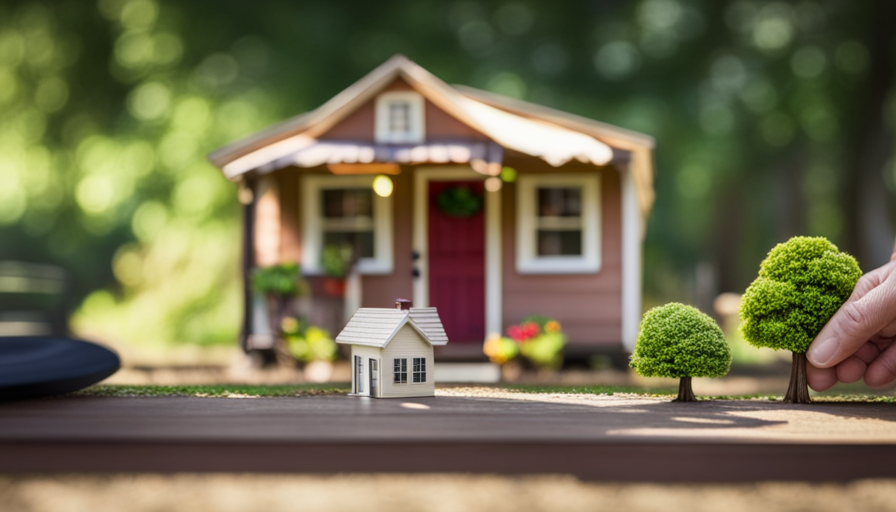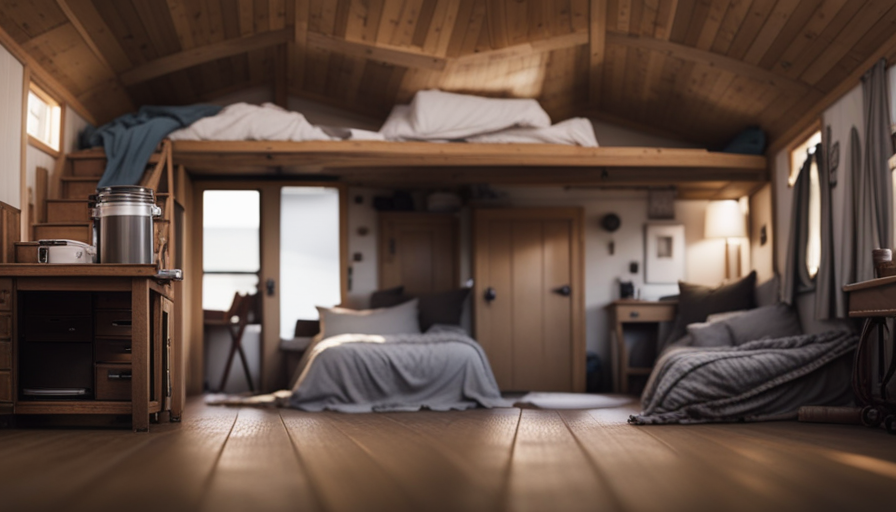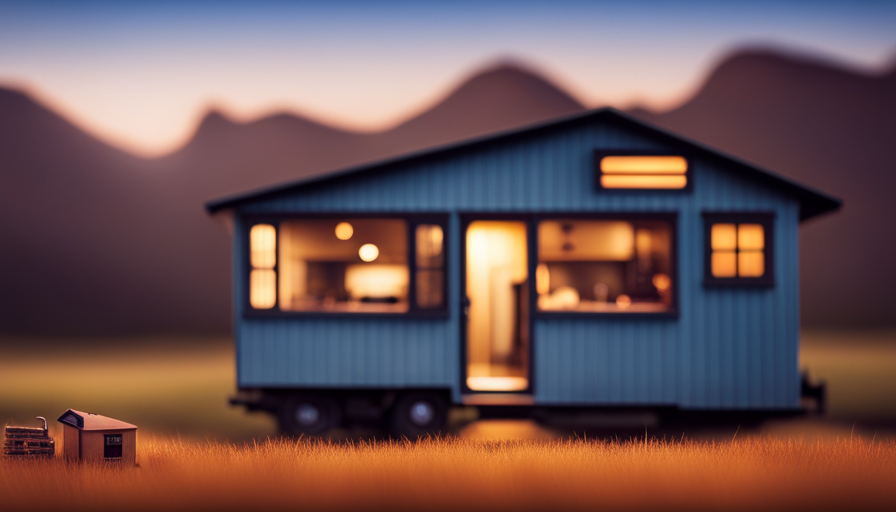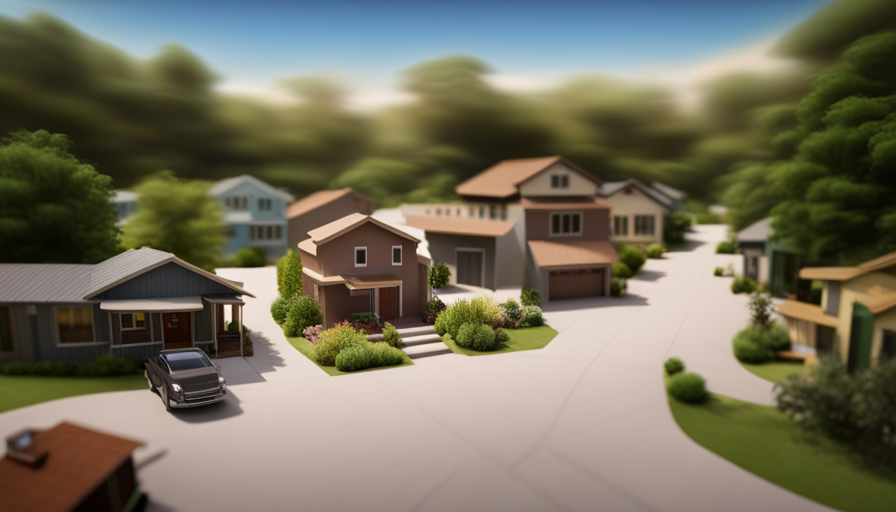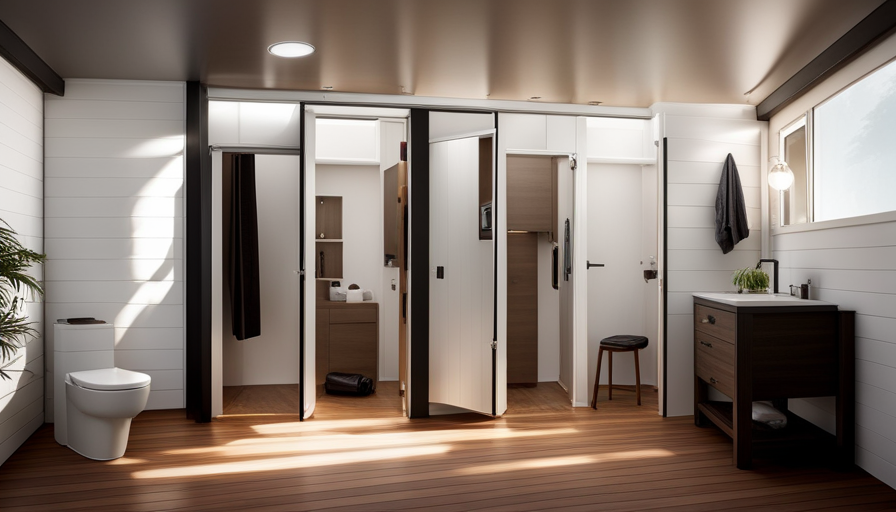You may be wondering, “What are the odds of selling a tiny house in my area?” It’s a valid concern considering the unique features of tiny houses and the specific market they cater to. But fear not, as I am ready to provide you with an impartial and evidence-based evaluation of the situation.
One might argue that the market demand for tiny houses in your area may not be substantial enough to guarantee a successful sale. However, recent trends suggest otherwise. The demand for tiny houses has been steadily increasing, with more and more people embracing the minimalist lifestyle and seeking affordable housing options.
To increase your chances of selling your tiny house, it’s crucial to price it competitively and employ effective marketing strategies. Highlighting the unique features of your tiny house and understanding the target market will also play a significant role in attracting potential buyers.
In this article, we will delve deeper into these topics, explore legal compliance, and offer tips for preparing your tiny house for sale. Whether you choose to work with a real estate agent or sell independently, patience and persistence will be key throughout the selling process.
So let’s dive in and discover the possibilities!
Key Takeaways
- Market demand for tiny houses is increasing due to interest in minimalistic and sustainable living.
- Thorough market research is necessary to determine the right price range.
- Effective marketing strategies, such as online advertising and highlighting unique features, are essential to attract potential buyers.
- Understanding the target market and location play a crucial role in successful selling.
Market Demand for Tiny Houses in Your Area
How likely is it that you can sell a tiny house in your area, considering the market demand? To answer this question, it’s crucial to understand the current market trends and buyer preferences.
In recent years, there’s been a growing interest in tiny houses across the country. This trend is driven by various factors, including an increasing desire for minimalistic and sustainable living, as well as the affordability and flexibility that tiny houses offer.
In your specific area, it’s essential to assess the demand for tiny houses. Look for indicators such as the number of existing tiny house communities, the presence of builders specializing in tiny houses, and any local media coverage on the topic. Additionally, consider the demographics of your area and whether there’s a demand for smaller, more affordable housing options.
Understanding buyer preferences is equally important. Many individuals interested in tiny houses prioritize features such as energy efficiency, clever storage solutions, and functional layouts. Conducting market research and analyzing what potential buyers are looking for can help you tailor your tiny house to meet their needs.
As you delve into pricing your tiny house competitively, it’s crucial to consider the market demand and buyer preferences you’ve identified. By aligning your pricing strategy with these factors, you can increase the chances of selling your tiny house successfully.
Pricing Your Tiny House Competitively
Pricing your little abode competitively will make your potential buyers swoon over the deal. To determine the right price for your tiny house, it’s crucial to conduct thorough market research and analyze pricing strategies.
Start by researching similar properties in your area to get an idea of their price range. Look at factors such as size, location, amenities, and overall condition. This will give you a baseline to work with.
Next, consider the unique features and selling points of your tiny house. Does it have any special design elements or eco-friendly features? These factors can help justify a higher price. On the other hand, if your tiny house requires some repairs or updates, you may need to adjust the price accordingly.
To attract potential buyers, it’s important to price your tiny house competitively within the market. If you set the price too high, it may deter buyers, but if you set it too low, you may miss out on maximizing your profit. Finding the right balance is key.
Incorporate different pricing strategies such as pricing slightly below market value to attract more interest, or pricing at market value and highlighting the unique features to justify the price. It’s also a good idea to consult with a real estate professional who specializes in tiny houses to get their insights and expertise.
By conducting thorough market research and utilizing effective pricing strategies, you can increase the likelihood of selling your tiny house successfully.
In the next section, we will explore marketing strategies for selling your tiny house and attracting potential buyers.
Marketing Strategies for Selling Your Tiny House
To successfully market and attract eager buyers, it’s essential to employ effective strategies when selling your adorable little sanctuary. In order to do so, conducting thorough market research is crucial. This will help you understand the demand for tiny houses in your area and determine a competitive price point.
Additionally, online advertising plays a significant role in reaching potential buyers. Utilize social media platforms and popular real estate websites to showcase your tiny house and generate interest.
Here are five emotional triggers to consider when crafting your marketing strategy:
- Create a sense of coziness and comfort by highlighting the warm and inviting interior design of your tiny house.
- Emphasize the freedom and simplicity that comes with living in a tiny house, appealing to those seeking a minimalist lifestyle.
- Showcase the eco-friendly features of your tiny house, such as solar panels or energy-efficient appliances, to attract environmentally conscious buyers.
- Highlight the potential for adventure and travel by emphasizing the mobility and portability of your tiny house.
- Evoke a sense of community and connection by showcasing any unique communal spaces or shared amenities in the vicinity of your tiny house.
By implementing these strategies, you can effectively market your tiny house and attract potential buyers.
In the next section, we will explore how to highlight the unique features of your tiny house to further captivate interested individuals.
Highlighting the Unique Features of Your Tiny House
Showcasing the charming and one-of-a-kind elements of your cozy sanctuary will captivate potential buyers. When it comes to selling your tiny house, highlighting its unique features is crucial. These features set your tiny house apart from traditional homes and attract buyers who are looking for something different.
One way to highlight these features is through effective staging techniques. Start by emphasizing the compact yet functional layout of your tiny house. Showcase how every inch of space has been optimized for maximum efficiency. Highlight the clever storage solutions, such as built-in cabinets and multi-functional furniture. Additionally, draw attention to the unique architectural elements, like the vaulted ceilings or the large windows that flood the space with natural light.
Another way to highlight the unique features of your tiny house is through thoughtful interior design. Use a cohesive color palette and showcase the use of sustainable materials. Incorporate elements of nature, such as plants or natural textures, to create a calming and inviting atmosphere. Consider adding small touches of luxury, like a spa-like bathroom or a gourmet kitchen, to appeal to potential buyers.
By highlighting the unique features and utilizing effective staging techniques, you can make your tiny house stand out in the market. Understanding the target market for tiny houses is the next crucial step in successfully selling your cozy sanctuary.
Understanding the Target Market for Tiny Houses
Imagine connecting with a group of like-minded individuals who crave simplicity, minimalism, and the freedom to explore. Understanding the target market for tiny houses allows you to tap into this community and find the perfect buyer for your unique sanctuary.
To effectively target the market for tiny houses, conducting market research is crucial. This involves analyzing demographics, preferences, and trends. By understanding the target market, you can tailor your marketing efforts and highlight the features of your tiny house that will resonate with potential buyers.
Some key aspects to consider are:
-
Lifestyle: Tiny houses appeal to those seeking a simpler, more sustainable lifestyle. Highlight how your tiny house promotes minimalism and a closer connection with nature.
-
Location: Explore areas with a high demand for alternative housing options, such as eco-friendly communities or areas with a strong tiny house movement.
-
Affordability: Emphasize the cost savings and financial freedom that come with owning a tiny house.
-
Customization: Highlight the flexibility and personalization options available in your tiny house design.
By analyzing the target market for tiny houses and tailoring your marketing strategy accordingly, you can effectively reach potential buyers who are genuinely interested in the unique lifestyle your tiny house offers. This will help you build a network of potential buyers who share your passion for simplicity and exploration.
Building a Network of Potential Buyers
Connect with a vibrant community of individuals who share your passion for simplicity and exploration by building a network of potential buyers for your unique sanctuary. Building a buyer’s list is crucial to increase your chances of selling a tiny house in your area.
Start by reaching out to local tiny house communities and online platforms dedicated to tiny house enthusiasts. These platforms provide an excellent opportunity to showcase your tiny house to a targeted audience who are actively seeking such properties.
Utilize social media platforms like Facebook, Instagram, and Twitter to connect with potential buyers. Join relevant groups and communities, share captivating photos and videos of your tiny house, and engage with people who show interest. This allows you to build relationships and establish credibility within the tiny house community.
Consider attending tiny house events, workshops, and meetups in your area. These gatherings attract people who are genuinely interested in tiny houses and may be potential buyers. Network with other tiny house owners, builders, and enthusiasts to expand your reach and gain valuable insights into the market.
By building a network of potential buyers, you can increase the visibility of your tiny house and attract interested individuals who are more likely to make a purchase. Once you have established this network, you can focus on ensuring legal compliance for selling your tiny house without any hassle.
Ensuring Legal Compliance for Selling Your Tiny House
Ensuring legal compliance for selling your compact dwelling can be a labyrinthine process, but with careful research and expert guidance, you can navigate the intricate legal landscape seamlessly. Here are some key steps to ensure you are on the right track:
-
Ensuring proper documentation: Before putting your tiny house on the market, it’s crucial to have all the necessary paperwork in order. This includes obtaining a certificate of occupancy, which verifies that your dwelling meets all relevant building codes and safety standards.
-
Navigating zoning regulations: Zoning laws vary from one area to another, and it’s important to understand how they apply to your tiny house. Research local zoning regulations to ensure that your tiny house is allowed in your area and comply with any specific requirements or restrictions.
-
Consult with legal professionals: To ensure you’re fully compliant with all legal requirements, consider consulting with legal professionals experienced in real estate and zoning laws. They can provide valuable guidance and help you navigate any potential legal hurdles.
-
Obtain permits: Depending on your location, you may need to obtain permits for various aspects of selling your tiny house, such as conducting open houses or even transporting the house to a new location. Make sure to research and secure any required permits in advance.
-
Keep records: Throughout the process of selling your tiny house, it’s important to keep detailed records of all legal documentation, permits, and any correspondence related to the sale. This will help protect you in case of any legal disputes or inquiries.
Ensuring legal compliance and navigating the intricacies of the legal landscape is crucial when selling your tiny house. After addressing these legal aspects, it’s time to move onto preparing your tiny house for sale.
Preparing Your Tiny House for Sale
Now that I’ve made sure my tiny house is legally compliant, it’s time to prepare it for sale. To ensure a successful sale, I need to conduct thorough market research and implement effective staging techniques.
Market research will help me understand the demand for tiny houses in my area and set a competitive price. By analyzing recent sales data and comparing similar properties, I can determine a fair asking price that will attract potential buyers.
Once I have a price in mind, I can focus on staging my tiny house to make it more appealing to buyers. This involves decluttering and organizing the space to maximize its potential. I’ll also consider small renovations or updates that can add value and make the house stand out in the market.
In addition to physical preparations, I’ll also explore different marketing strategies to reach potential buyers. This can include listing the tiny house on relevant online platforms, advertising in local publications, or hosting open houses to showcase its unique features.
By conducting thorough market research and implementing effective staging techniques, I can increase the likelihood of selling my tiny house quickly and at a desirable price. Once these preparations are complete, I can move on to the next step of either working with a real estate agent or selling independently.
Working with a Real Estate Agent or Selling Independently
When it comes to selling my tiny house, I need to evaluate the pros and cons of working with a real estate agent or selling independently.
Hiring a real estate agent can provide me with expertise and access to a wider network of potential buyers, but it also comes with a commission fee.
On the other hand, selling independently allows me to have more control over the process and save on commission fees, but it requires more time and effort in marketing and negotiating.
Ultimately, I will need to carefully consider my priorities and resources to determine the best approach for selling my tiny house.
Evaluate the Pros and Cons of Each Option
Considering the pros and cons of each option, you might be wondering just how likely it is that you can sell a tiny house in your area. When evaluating the advantages and disadvantages of selling independently, it’s important to weigh the potential cost savings against the time and effort required to market and sell the property on your own.
Selling independently allows you to have full control over the process, but it also means you’ll need to handle all aspects of marketing, negotiations, and paperwork yourself. On the other hand, working with a real estate agent can provide you with their expertise and industry knowledge, but it does come with commission fees.
Additionally, exploring the effectiveness of utilizing social media for marketing can greatly expand your reach and attract potential buyers.
In conclusion, evaluating these options will help you determine the best approach for selling your tiny house.
Determine the Best Approach for Selling Your Tiny House
Deciding on the most effective method to sell your adorable little home can be a game-changer for attracting potential buyers. To ensure success, it is crucial to utilize the best advertising methods and staging techniques. By effectively showcasing the unique features and benefits of your tiny house, you can capture the attention of interested buyers. One way to advertise your tiny house is through online platforms such as social media, real estate websites, and online classifieds. Additionally, hosting open houses and participating in local home shows can also attract potential buyers. To further enhance the appeal of your tiny house, consider staging it with stylish furniture and decor that maximizes the use of space. Remember, patience and persistence in the selling process are key to finding the perfect buyer for your tiny house. Transitioning into the subsequent section, let’s explore the importance of patience and persistence in selling your tiny house.
Patience and Persistence in the Selling Process
When it comes to selling a tiny house, it’s important to be prepared for a longer selling timeline. This is because the market for tiny houses may be smaller and it may take time to find the right buyer.
Additionally, staying positive and open to negotiations is crucial in order to reach a successful sale. By being patient and persistent in the selling process, I can increase my chances of selling my tiny house in my area.
Be Prepared for a Longer Selling Timeline
Don’t expect to sell your tiny house in a flash; be ready for a selling timeline that feels longer than waiting for a snail to finish a marathon. Selling a tiny house requires patience and persistence, especially considering the unique market dynamics and pricing challenges. To effectively navigate this process, conducting thorough market research is crucial. Understanding the demand and competition in your area will help you determine a realistic pricing strategy. By comparing similar listings and taking into account factors such as location, amenities, and condition, you can set a competitive price that attracts potential buyers. Remember, selling a tiny house may take longer than selling a traditional home due to its niche market. However, staying positive and open to negotiations can increase your chances of a successful sale. Transitioning into the next section, it’s important to maintain a proactive mindset throughout the selling journey.
Stay Positive and Open to Negotiations
Stay optimistic and maintain an open mindset when it comes to negotiating with potential buyers, allowing for a smoother and more successful selling experience. Staying positive throughout the process can make a significant difference in achieving the desired outcome.
When it comes to negotiating, it’s essential to approach it with a skillful mindset. Develop strong negotiation skills by researching market trends, understanding the value of your tiny house, and being prepared to present its unique features and advantages. Additionally, be open to the possibility of compromises and find common ground with potential buyers.
Flexibility in terms of price, timing, or other terms can help facilitate a successful negotiation. By staying optimistic and honing your negotiation skills, you increase the likelihood of selling your tiny house in your area.
Frequently Asked Questions
How long does it typically take to sell a tiny house in my area?
Typically, it takes around 3 to 6 months to sell a tiny house in my area. However, this can vary depending on factors such as location, condition, and demand.
The average selling price of a tiny house in my area is $80,000. To increase the chances of selling quickly, it’s crucial to employ effective marketing strategies like showcasing the unique features of the house, utilizing social media platforms, and targeting potential buyers interested in minimalistic living.
Can I sell my tiny house without making any repairs or renovations?
I can sell my tiny house without making any repairs or renovations, but it may affect the likelihood of selling it and the price I can get. Selling a tiny house ‘as is’ means potential buyers will consider the condition of the house and may negotiate for a lower price.
However, the demand for tiny houses and the specific market conditions in my area will ultimately determine the success of selling my house without any improvements.
Are there any specific zoning regulations or restrictions I need to be aware of when selling my tiny house?
When selling a tiny house, it’s important to be aware of the specific zoning regulations and legal requirements in your area. These regulations determine where and how a tiny house can be placed, as well as any size or design restrictions. It’s crucial to research and comply with these regulations to ensure a smooth and legal selling process.
By understanding and adhering to zoning regulations, you can increase the chances of selling your tiny house successfully.
What are some effective ways to negotiate the price of my tiny house with potential buyers?
When negotiating the price of my tiny house with potential buyers, I employ effective negotiation strategies and pricing techniques.
Firstly, I gather data on recent sales of comparable tiny houses in the area to establish a fair market value.
I then highlight the unique features and benefits of my house to justify its price.
Additionally, I’m open to reasonable offers and willing to negotiate to reach a mutually satisfactory agreement.
Are there any tax implications or considerations when selling a tiny house?
Tax implications should be considered when selling a tiny house. One interesting statistic to note is that if you’ve owned the tiny house for less than a year, any profits from the sale may be subject to short-term capital gains tax, which is typically higher than long-term capital gains tax rates. It’s important to consult with a tax professional to understand the specific implications based on your individual circumstances.
Conclusion
In conclusion, selling a tiny house in my area can be a challenging yet rewarding endeavor. By understanding the market demand, pricing competitively, and implementing effective marketing strategies, the chances of selling your tiny house increase significantly.
Highlighting the unique features and targeting the right market are essential in attracting potential buyers. It’s vital to ensure legal compliance and prepare the tiny house for sale.
Whether working with a real estate agent or selling independently, patience and persistence are key. So, don’t miss out on this incredible opportunity to sell your tiny house and make your dreams come true!
Hi, I’m Emma. I’m the Editor in Chief of Tiny House 43, a blog all about tiny houses. While tree houses are often associated with childhood, they can be the perfect adult retreat. They offer a cozy space to relax and unwind, surrounded by nature. And since they’re typically built on stilts or raised platforms, they offer stunning views that traditional homes simply can’t match. If you’re looking for a unique and romantic getaway, a tree house tiny house might just be the perfect option.
